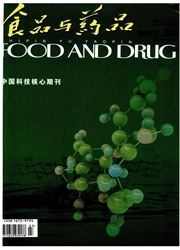

 中文摘要:
中文摘要:
目的优化维生素E(VE)脂质体的制备工艺并考察其性质。方法采用乙醇注入法、乙醚注入法、逆相蒸发法、薄膜水化法和复乳法分别制备v。脂质体,以包封率和保留率为考察指标,选择最优制备方法;经L9(3^4)正交试验设计优化选择,确定脂质体的最佳配方。结果薄膜水化法制备所得的VE脂质体包封率最高,VE保留率较高;用薄膜水化法制备脂质体的最佳配方为磷脂:VE:胆固醇=20:0.8:1.5;用透射电镜观察最佳实验组VE脂质体发现其具有指纹状结构,Zeta电位为.30.9±0.9mV,平均粒径为33.7nm。结论薄膜水化法制得的V。脂质体具有包封率高,VE保留率高,粒径均匀等特点。
 英文摘要:
英文摘要:
Objective To optimize the preparation process of vitamin E(VE) liposome and study its characteristics. Methods The VE liposomes were prepared by five different kinds of methods including ethanol injection method, ether injection method, reverse-phase evaporation method, the thin film hydration method and the double emulsion method. Taking the encapsulation efficiency and conserving rate ofVE liposomes as the evaluation indexes, the optimal preparation method was determined. And the prescription of VE liposome was optimized by a L 9 ( 3^4 ) orthogonal design. Results The thin film hydration method was chosen to prepare the VE liposome for the highest encapsulation efficiency and higher conserving rate, and the optimal formula was: phospholipids/VE/cholesterol=20/0.8/1.5. The TEM images of VE liposome prepared with optimal formula indicated that the liposome had the fingerprint structure, the zeta potential and average particle size of VE liposome were -30.94-0.9 mV and 33.7 nm, respectively. Conclusion The VE liposome prepared with the thin film hydration method can have higher encapsulation efficiency and conserving rate Of VE and narrower particle size distribution.
 同期刊论文项目
同期刊论文项目
 同项目期刊论文
同项目期刊论文
 Injectable thermosensitive hydrogel based on chitosan and quaternized chitosan and the biomedical pr
Injectable thermosensitive hydrogel based on chitosan and quaternized chitosan and the biomedical pr Preparation and characteristics of novel porous hydrogel films based on chitosan and glycerophosphat
Preparation and characteristics of novel porous hydrogel films based on chitosan and glycerophosphat 期刊信息
期刊信息
